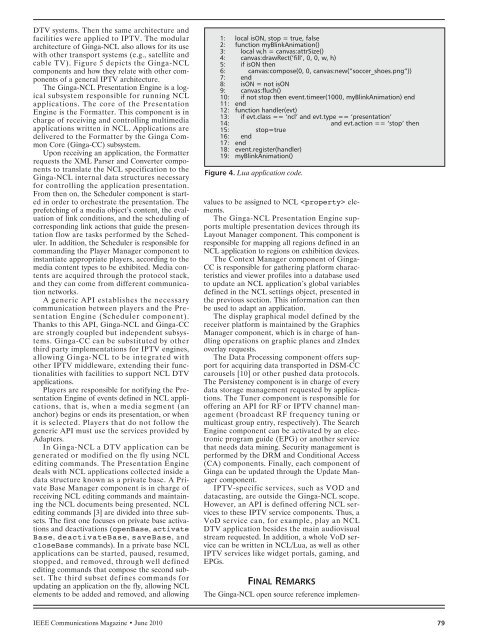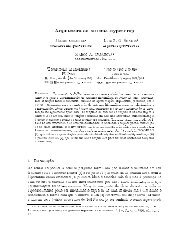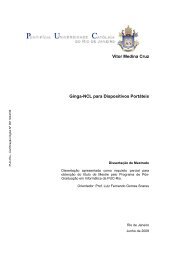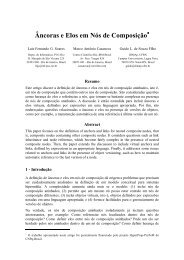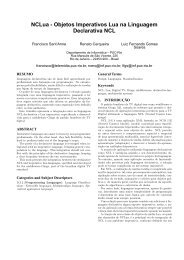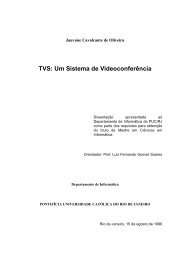Ginga-NCL: Declarative Middleware for Multimedia IPTV Services
Ginga-NCL: Declarative Middleware for Multimedia IPTV Services
Ginga-NCL: Declarative Middleware for Multimedia IPTV Services
You also want an ePaper? Increase the reach of your titles
YUMPU automatically turns print PDFs into web optimized ePapers that Google loves.
DTV systems. Then the same architecture and<br />
facilities were applied to <strong>IPTV</strong>. The modular<br />
architecture of <strong>Ginga</strong>-<strong>NCL</strong> also allows <strong>for</strong> its use<br />
with other transport systems (e.g., satellite and<br />
cable TV). Figure 5 depicts the <strong>Ginga</strong>-<strong>NCL</strong><br />
components and how they relate with other components<br />
of a general <strong>IPTV</strong> architecture.<br />
The <strong>Ginga</strong>-<strong>NCL</strong> Presentation Engine is a logical<br />
subsystem responsible <strong>for</strong> running <strong>NCL</strong><br />
applications. The core of the Presentation<br />
Engine is the Formatter. This component is in<br />
charge of receiving and controlling multimedia<br />
applications written in <strong>NCL</strong>. Applications are<br />
delivered to the Formatter by the <strong>Ginga</strong> Common<br />
Core (<strong>Ginga</strong>-CC) subsystem.<br />
Upon receiving an application, the Formatter<br />
requests the XML Parser and Converter components<br />
to translate the <strong>NCL</strong> specification to the<br />
<strong>Ginga</strong>-<strong>NCL</strong> internal data structures necessary<br />
<strong>for</strong> controlling the application presentation.<br />
From then on, the Scheduler component is started<br />
in order to orchestrate the presentation. The<br />
prefetching of a media object’s content, the evaluation<br />
of link conditions, and the scheduling of<br />
corresponding link actions that guide the presentation<br />
flow are tasks per<strong>for</strong>med by the Scheduler.<br />
In addition, the Scheduler is responsible <strong>for</strong><br />
commanding the Player Manager component to<br />
instantiate appropriate players, according to the<br />
media content types to be exhibited. Media contents<br />
are acquired through the protocol stack,<br />
and they can come from different communication<br />
networks.<br />
A generic API establishes the necessary<br />
communication between players and the Presentation<br />
Engine (Scheduler component).<br />
Thanks to this API, <strong>Ginga</strong>-<strong>NCL</strong> and <strong>Ginga</strong>-CC<br />
are strongly coupled but independent subsystems.<br />
<strong>Ginga</strong>-CC can be substituted by other<br />
third party implementations <strong>for</strong> <strong>IPTV</strong> engines,<br />
allowing <strong>Ginga</strong>-<strong>NCL</strong> to be integrated with<br />
other <strong>IPTV</strong> middleware, extending their functionalities<br />
with facilities to support <strong>NCL</strong> DTV<br />
applications.<br />
Players are responsible <strong>for</strong> notifying the Presentation<br />
Engine of events defined in <strong>NCL</strong> applications,<br />
that is, when a media segment (an<br />
anchor) begins or ends its presentation, or when<br />
it is selected. Players that do not follow the<br />
generic API must use the services provided by<br />
Adapters.<br />
In <strong>Ginga</strong>-<strong>NCL</strong> a DTV application can be<br />
generated or modified on the fly using <strong>NCL</strong><br />
editing commands. The Presentation Engine<br />
deals with <strong>NCL</strong> applications collected inside a<br />
data structure known as a private base. A Private<br />
Base Manager component is in charge of<br />
receiving <strong>NCL</strong> editing commands and maintaining<br />
the <strong>NCL</strong> documents being presented. <strong>NCL</strong><br />
editing commands [3] are divided into three subsets.<br />
The first one focuses on private base activations<br />
and deactivations (openBase, activate<br />
Base, deactivateBase, saveBase, and<br />
closeBase commands). In a private base <strong>NCL</strong><br />
applications can be started, paused, resumed,<br />
stopped, and removed, through well defined<br />
editing commands that compose the second subset.<br />
The third subset defines commands <strong>for</strong><br />
updating an application on the fly, allowing <strong>NCL</strong><br />
elements to be added and removed, and allowing<br />
1: local isON, stop = true, false<br />
2: function myBlinkAnimation()<br />
3: local w,h = canvas:attrSize()<br />
4: canvas:drawRect(’fill’, 0, 0, w, h)<br />
5: if isON then<br />
6: canvas:compose(0, 0, canvas:new(”soccer_shoes.png”))<br />
7: end<br />
8: isON = not isON<br />
9: canvas:fluch()<br />
10: if not stop then event.timeer(1000, myBlinkAnimation) end<br />
11: end<br />
12: function handler(evt)<br />
13: if evt.class == ‘ncl’ and evt.type == ‘presentation’<br />
14: and evt.action == ‘stop’ then<br />
15: stop=true<br />
16: end<br />
17: end<br />
18: event.register(handler)<br />
19: myBlinkAnimation()<br />
Figure 4. Lua application code.<br />
values to be assigned to <strong>NCL</strong> elements.<br />
The <strong>Ginga</strong>-<strong>NCL</strong> Presentation Engine supports<br />
multiple presentation devices through its<br />
Layout Manager component. This component is<br />
responsible <strong>for</strong> mapping all regions defined in an<br />
<strong>NCL</strong> application to regions on exhibition devices.<br />
The Context Manager component of <strong>Ginga</strong>-<br />
CC is responsible <strong>for</strong> gathering plat<strong>for</strong>m characteristics<br />
and viewer profiles into a database used<br />
to update an <strong>NCL</strong> application’s global variables<br />
defined in the <strong>NCL</strong> settings object, presented in<br />
the previous section. This in<strong>for</strong>mation can then<br />
be used to adapt an application.<br />
The display graphical model defined by the<br />
receiver plat<strong>for</strong>m is maintained by the Graphics<br />
Manager component, which is in charge of handling<br />
operations on graphic planes and zIndex<br />
overlay requests.<br />
The Data Processing component offers support<br />
<strong>for</strong> acquiring data transported in DSM-CC<br />
carousels [10] or other pushed data protocols.<br />
The Persistency component is in charge of every<br />
data storage management requested by applications.<br />
The Tuner component is responsible <strong>for</strong><br />
offering an API <strong>for</strong> RF or <strong>IPTV</strong> channel management<br />
(broadcast RF frequency tuning or<br />
multicast group entry, respectively). The Search<br />
Engine component can be activated by an electronic<br />
program guide (EPG) or another service<br />
that needs data mining. Security management is<br />
per<strong>for</strong>med by the DRM and Conditional Access<br />
(CA) components. Finally, each component of<br />
<strong>Ginga</strong> can be updated through the Update Manager<br />
component.<br />
<strong>IPTV</strong>-specific services, such as VOD and<br />
datacasting, are outside the <strong>Ginga</strong>-<strong>NCL</strong> scope.<br />
However, an API is defined offering <strong>NCL</strong> services<br />
to these <strong>IPTV</strong> service components. Thus, a<br />
VoD service can, <strong>for</strong> example, play an <strong>NCL</strong><br />
DTV application besides the main audiovisual<br />
stream requested. In addition, a whole VoD service<br />
can be written in <strong>NCL</strong>/Lua, as well as other<br />
<strong>IPTV</strong> services like widget portals, gaming, and<br />
EPGs.<br />
FINAL REMARKS<br />
The <strong>Ginga</strong>-<strong>NCL</strong> open source reference implemen-<br />
IEEE Communications Magazine • June 2010 79


